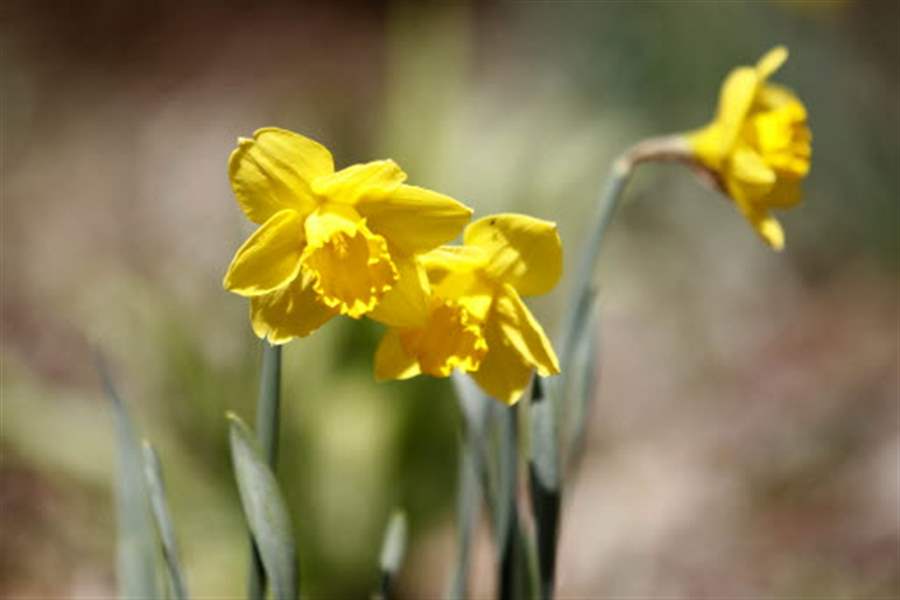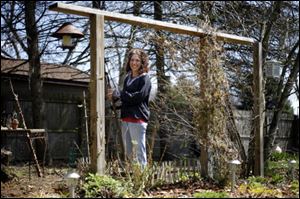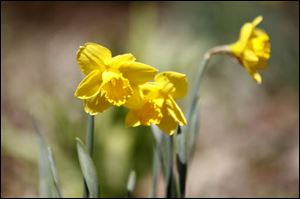
Weed it & Reap:
Rita Dreyer: Try companion planting
4/30/2011
Yellow Daffodils brighten Rita Dreyer's front garden.
THE BLADE/AMY E. VOIGT
Buy This Image

Rita Dreyer stands in one of her backyard gardens.
The Blade seeks gardeners for Weed It & Reap who are as varied as what they grow and who dig in gardens large, small, or with unusual content. In a sentence, tell us what’s unique about you or your garden. Contact Tahree Lane at tlane@theblade.com and 419-724-6075.
Name: Rita Dreyer; legal assistant, caterer, bartender; Swanton.
Garden specs: We live in my husband’s grandmother’s house on an acre, and have three large beds. The main garden, about 40-by-20 feet, is circular to maximize sun exposure. I’ll have a Native American three-sisters’ garden (corn, pole beans, watermelon), and in the front are perennial flowers. My husband, Chris, built a 12-by-12-foot raised bed for bush and pole beans (they climb on an old pergola frame) and on the outside perimeter are perennial herbs such as marjoram, thyme, oregano, chives, and self-seeding borage. The third area, behind the swimming pool, is 20-by 5-feet and will have tomatoes.
When did you start gardening? When I was a child, my parents always planted vegetables but it was a chore to weed and pick. We kind of hated it. I’ve had my own garden for five years. My husband calls gardening “my dirty little habit.”
What do you grow? Five varieties of pole and bush beans, six different heirloom tomatoes (my favorite is the Hillbilly, which was cultivated in Ohio), three varieties of eggplant (Rosa Bianca is our favorite), three types of corn, an array of hot peppers, tomatillos, asparagus, a mess of lettuce, spinach, broccoli raab, cucumbers, sweet-baby watermelon, zucchini, cucuzzi (a long, lime-colored Italian squash), sunflowers for the birds, and herbs including, parsley, basil, marjoram, oregano, chives, tarragon, borage, nasturtium, rosemary, lavender, mint, and sage.
My favorite plant has to be the tomato. Cal, my 11-year-old stepson, and I start seeds inside April and transplant them to the garden in late May. Growing an array of heirloom varieties ensures a constant supply of fresh tomatoes to eat, share, and can for the long winter months. There’s no better way to reopen the memories of summer than a jar of home-grown tomatoes in February.
Yellow Daffodils brighten Rita Dreyer's front garden.
Hours spent gardening: The hardest work is done in early April when I’m preparing the space and distributing compost. I’d estimate 12 hours a week. By July a couple hours a week maintains the spaces.
Annual expense: I save my own seeds from year to year which cuts the cost down and gives me the opportunity to grow varieties that would otherwise be unavailable at the local greenhouse. I spend about $150. When I started out, five years ago, it was $500. I’ve received a lot of perennials from friends.
Challenges: Companion planting is fascinating and my research never ends. The herb, borage, for example, provides endless benefits and it self sows. It improves the ability of surrounding plants to fight disease, is known as a general insect repellent, and deters tomato hornworm. And its bright blue flowers taste like mild cucumber. When basil’s leaves are bruised, they repel flies and mosquitoes, so it’s good to keep a pot on the patio. Nasturtiums deter aphids and beetles, and are edible. A patch of mint repels slugs. Garlic deters bunnies. And birds eat their weight in bugs, so we have bird feeders. The concept of using herbs to deter bugs is brilliant, but setting up the garden’s ecosystem to work together is a battle I don’t always win.
I’m proud of when children walk through the path in the main garden and tell me what they remember about the plants from year to year. Cal understands the importance of crop rotation. He’s become my harvester and I’m proud that he has an interest in growing food and living off the land.
What I’ve learned from gardening: It has honestly changed my life. I take every day stress and rework it in the soil, turning it into positive energy. The earth has an amazing way of rewarding our efforts with the priceless gifts of vegetables, flowers, birds, butterflies, and hummingbirds. Plants and native wildflowers can transform your yard into a sanctuary that can benefit the Oak Openings region. What a great reward for something that I love!